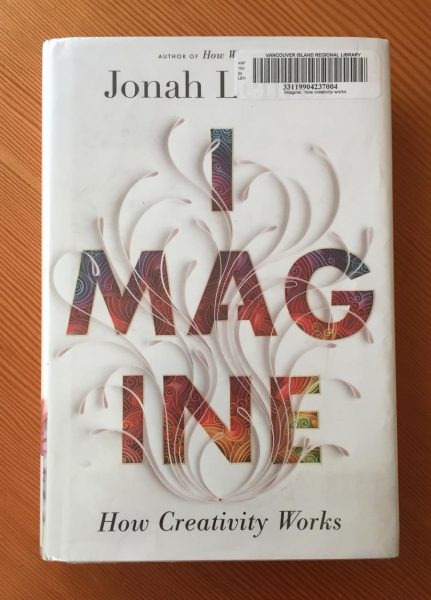Book Review: "Imagine: How Creativity Works" by Jonah Lehrer

The book “Imagine” was recommended to me by a visitor on the studio tour. The main lesson in this book is that creativity shouldn’t be thought of as strictly the realm of artists or inventors but that all humans are hard wired to be creative – “creativity is a catchall term for a variety of distinct thought processes”.
I enjoyed reading real life accounts of how masking tape was invented or how Bob Dylan wrote songs as well as the scientific research that backed up these stories. We often take things like a Swiffer or the Pixar movie Toy Story for granted – they automatically become part of our cultural landscape. However, these products may take an entire lifetime to create – the result of an unexplainable insight, or years of painstaking trial and error work; however, they are usually a combination of both.
I liked hearing how “the act of being stumped” is part of the creative process and often an insight will occur after we have stopped looking for answers. Once we relax, the right hemisphere, which is great at making new connections, can start working on the problem. For example, it was only when Bob Dylan was burnt out and decided to quit being a musician that his ground breaking song “Like a Rolling Stone” came to him as an unstoppable flow of words, starting the most inspired phase of his career.
Lehrer also quotes research on how happiness and positive moods can lead to dramatic increases in creativity (you don’t have to be depressed to create); however sadness and melancholy may assist us in being able to sit and focus on working out a problem.
According to this book, there are two types of creative thinking “divergent” and “convergent”. Divergent thinking is about unexpected thoughts and making random associations whereas convergent thinking is about analysis and attention. I could relate this to my own process as I start exploring ideas with loose sketches or collages (divergent) and then later switch to an intense editing process – changing colours or composition until things look just right. This is why I often say “I’m slow”! I’m not the only one. Like Milton Glaser who designed many famous logos including the “I (heart) NY” logo; “it’s only by really thinking about something that we’re able to move ourselves into perceptions that we never knew we had the capacity for”.
Other famous people were analysed for their creative process, such as the cellist YoYo Ma, who likes to let go of worry about performance and connect with his sense of fun and David Byrne (Talking Heads) who is inspired by cities where he sees “every street as a mixed tape”. The main thing is that “being creative” is about fashioning your life in a way that allows for creativity to happen, whether it is travelling to new places and meeting new people or “productive daydreaming”. It is also about having grit – working hard and persevering in spite of obstacles. We all have imaginations, “we just have to learn how to listen”.
Thanks for reading. Happy Creating, Tracy

